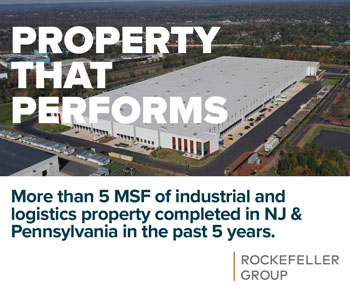Left to right: Clark Machemer, senior vice president and regional development officer with the Rockefeller Group; Chris Sullens, CEO and president of WorkWave; Rita Gurevich, founder and president of SPHERE Technology Solutions, and Christian Kopfli, CEO of Chromocell Corp.
By Joshua Burd
For someone who spends his time thinking about the office user of the future, Clark Machemer found himself in good company on Thursday night.
That’s because he was sharing a stage with three top executives, including two who lead fast-growing technology firms in the state and a third from a cutting-edge life sciences company.
“I speak often about the next generation of companies in New Jersey and (ask), ‘Are they going to locate in Jersey versus New York, Boston, Austin or some of those other metropolitan areas?’ ” said Machemer, a senior vice president with the Rockefeller Group. “What we’re looking at here is proof that innovative companies are choosing New Jersey.”
It was just one of the questions that Machemer, president of NAIOP New Jersey, raised Thursday night during a panel discussion hosted by the commercial real estate group. With developers and professionals looking on, the program focused on why and how those companies are able to grow in the Garden State — and how the commercial real estate industry can support them in their growth.
Balancing projected growth with the needs of a landlord
A case in point is WorkWave CEO Chris Sullens, whose firm develops cloud-based software for field service and fleet management. The Neptune-based company has grown rapidly — even exceeding its own expectations — by expanding from about 75 people three years ago to 175 today.
In the process, WorkWave has outgrown spaces of both 12,000 and 23,000 square feet before its leases expired, which can mean having to find a subtenant while it searches for a larger office and a short-term stopgap. But the firm expects to put those concerns to rest with what will be its new home, the 2 million-square-foot Bell Works building in Holmdel, where it has leased 72,000 square feet with options to take as much as 220,000 square feet in the coming years.
For WorkWave, having a landlord that had both the space and the willingness to offer those options was critical.
“That’s the kind of thing you need,” Sullens said during the event in Jersey City. “We’re planning for success, but I don’t want to get into the situation that we’re in now, which is the long lease that we have to sublease and move, anyway.’
“The dichotomy between those two things makes it really hard for companies like ours.”
Christian Kopfli, CEO of Chromocell Corp., agreed that flexibility is paramount. He pointed to the “the dynamic, the speed and the unpredictability” of growing a startup — all issues he has faced in building the North Brunswick-based biotech firm.
“(It) is such an incredibly big factor in your planning,” said Kopfli, whose firm focuses on both flavors and therapeutics. “It really keeps you up and it makes those longer-term leases the reason for nightmares, quite honestly, because you can go one of two directions.
“You can have too little space and you quickly have to go out and sublet, or even though the business on the long term is going to grow, you don’t grow so quickly, as you wished. Then you have all of the costs that you have to absorb.”
The company has had help from the state Economic Development Authority, the landlord of the Commercialization Center for Innovative Technologies in North Brunswick. Chromocell started in incubator space at the campus before moving to a larger building at the center in 2009.
The role of brokers
Having the right broker can make all the difference, according to Rita Gurevich, founder and president of SPHERE Technology Solutions. The Jersey City-based firm, which specializes in data security compliance for regulated industries, has moved and expanded several times over the past seven years and has relied on real estate professionals each time.
For brokers, getting that business is often based on word of mouth and referrals, she said, but there are other ways to get the attention of a growing firm.
“I would say the best way to reach out to people, if you’re interested in starting a discussion, is offer something of value to them — different studies about your area and different programs that competitive companies have taken advantage of — and opening the dialogue like that,” Gurevich said. “But the world cannot exist without brokers. I would never be able to make my company grow if I didn’t have brokers that I could trust that were helping me find real estate.”
Amenities and shared spaces
Sullens said he has always sought to create the right environment within the four walls of his office, but also focused on training areas, meetings rooms and the like. But for a company with hundreds of employees, common areas can be a huge investment.
It’s why he touted the model of Bell Works, which offers spaces such as a 300-seat auditorium that’s available to all tenants in the building.
“We saw that opportunity and saw the benefit in our floor plan of not having to build some of those spaces in,” Sullens said. “It doesn’t get captured in the dollars per square foot, but it becomes a pretty big benefit for companies as you’re trying to find places to gather your employees — and not have to carve off a huge footprint to be able to do that when you’re doing it once a month or once a quarter.”
Gurevich said she has focused primarily on newer buildings, largely because that makes it easier to set up telecom, data center requirements and other “infrastructure that goes into getting a company up and running.” Being in a new building — in a popular location — also helps with the challenge of attracting young, tech-savvy employees.
“Talent is the other really big one, so depending on who you’re attracting, you really need to make sure you’re moving your business close to where they live,” Gurevich said. “There are so many options right now, especially in the tech sector, that you have to be competitive — and location is a competitive factor.”










